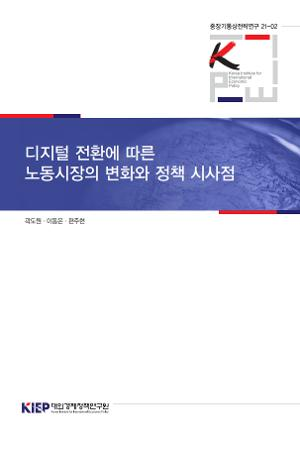Policy Analyses
Publications
Policy Analyses
To list

Digital Transformation and Its Impact on Labor Market Outcomes: Analyses Based on Country-Level, Korean Workers, and Korean Firm-Level Data
labor market, electronic commerce
Author Do Won Kwak, Dong-Eun Rhee, and Ju Hyun Pyun Series 21-02 Language Korean Date 2021.12.30
Digitalization in production and distribution has been progressing continuously for the past 30 years. In the past decade, led by advances in artificial intelligence and machine learning technologies, digital transformation has accelerated further. As a result, the effect of digital transformation on labor market outcomes has become more evident recently. There are two opposing hypotheses about the impact of digital transformation on the labor market: a decrease in labor demand due to labor substitution and an increase in labor demand due to a rise in productivity. This study empirically quantifies the changes that digital transformation brings to the labor market based on data at various country, firm, and industry levels.
In a country-level analysis in chapter 2, we find the expansion of e-commerce has been shown to lower the employment rate and increase the unemployment rate. Looking at the heterogeneous effects according to educational background, the negative impact of the expansion of e-commerce on employment and unemployment was more significant in the low-educated workers. In the heterogeneous effect analysis by age, the negative effect on labor and unemployment was substantial in the working population aged 25 and over. In sum, the expansion of e-commerce has had a significant negative impact on the working population aged 25 and over and the low-educated population.
Chapter 3 analyzes the effect of the development and utilization of digital transformation technologies such as the Internet of Things (IoT), big data, and robotics on firms' employment and labor productivity in manufacturing and service industries using the 2016-2018 Business Activity Survey, collected from the Statistics Korea. We find that the development and use of digital transformation technology reduce firm‘s employment with relatively low average wages in the manufacturing industry. This implies that the impact of digital transformation technology on firm employment depends on labor characteristics (e.g., required skills) in the manufacturing industry, which can be inferred from the wage level. Finally, we find that the development and use of digital transformation technology had a relatively more positive effect on service firms' employment and labor productivity. This is because the service industry relies more on human capital than physical capital in the production process than the manufacturing industry.
In chapter 4, using 38 industries data from Korea Productivity Center for the period 1995-2018, we study the effect of labor productivity improvement on employments and wages. We find an increase in labor productivity reduces labor demand through the substitution effect. However, considering the externalities between industries, we positively affect labor demand through between-industry externality. As a result of estimating the heterogeneous effect (i) the negative (-) effect on employment through the substitution effect was found to be driven by large companies, and (ii) service industry. It was also found that the service industry absorbs the positive (+) externalities most significantly. For the effect of an increase in labor productivity on labor income, we find that the share of labor income has gradually decreased since 1995 with an increase in labor productivity.
In chapter 5, using PIAAC data, we identify skill items that showed a high positive correlation with employment and wage. We find that the most significant increase in employment occurred in industries with high utilization skills of physical labor and ICT proficiency. On the other hand, the most considerable wage increase occurred in sectors with high utilization skills of continuous education and systematic and planned work performance. Industries with these skills showed a high negative correlation with high employment. At the individual level estimations, we find no significant change in employment and wage found for professional workers. The significant effect in employment was concentrated on non-professional workers.
The results of empirical analysis at the country, firm, and industrial level consistently show that the impact of digital transformation on the labor market differs depending on the level of skill and education. To mitigate the negative impact of digital transformation on the labor market, the government should provide professional vocational education to develop high problem-solving and ICT-related skills in addition to the knowledge provided by university education. Furthermore, the government can improve the efficiency of the labor market by promoting the smooth transition between jobs and re-employment of displaced workers through the establishment of a strong educational infrastructure. High-quality skill education, vocational job training education, personalized education, and online education should be accessible to the greater population. The government should guarantee no worker is getting behind to attain proper skills to work at the age of digital transformation.
Sales Info
| Quantity/Size | 164 |
|---|---|
| Sale Price | 7 $ |
 공공저작물 자유이용허락 표시기준 (공공누리, KOGL) 제4유형
공공저작물 자유이용허락 표시기준 (공공누리, KOGL) 제4유형
대외경제정책연구원의 본 공공저작물은 "공공누리 제4유형 : 출처표시 + 상업적 금지 + 변경금지” 조건에 따라 이용할 수 있습니다. 저작권정책 참조
